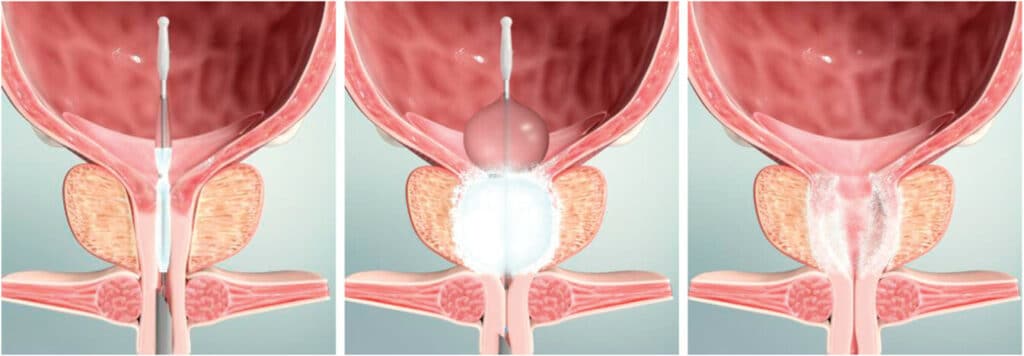Last Updated on July 7, 2024 by Max
Introduction
Benign Prostatic Hyperplasia (BPH), commonly known as an enlarged prostate, is a condition that affects a significant number of men, particularly after 50. Traditional treatments have ranged from medications to surgeries like Transurethral Resection of the Prostate (TURP), which has been considered the gold standard for decades. However, these treatments often come with various side effects and a considerable recovery period, leading both patients and doctors to seek less invasive alternatives.
Enter the Optilume BPH Catheter System, a groundbreaking approach to BPH treatment that has recently garnered FDA approval. This minimally invasive technique is setting a new standard in prostate care by significantly reducing the discomfort and complications associated with conventional procedures. Utilizing a novel method that involves an inflatable catheter, the Optilume system not only improves urinary flow but does so with minimal side effects, marking it as a potential game-changer in the field.
The clinical community is buzzing about the effectiveness of Optilume, highlighted by its promising results in the recent PINNACLE and EVEREST clinical trials. These studies have demonstrated that the Optilume system can offer sustained symptom relief, a claim supported by robust data and welcomed by specialists and patients alike. As published in the American Urological Association’s Annual Meeting, the innovative treatment provided by Optilume represents a significant leap forward in how we manage BPH, paving the way for new standards in the field.
As we delve deeper into this exciting development, it’s clear that the Optilume BPH Catheter System is not just another treatment option but a potential revolution in minimally invasive prostate care. In this post, we’ll explore how it works, its advantages over traditional methods, and the impact it could have on millions of men worldwide.
- Introduction
- What is the Optilume BPH Catheter System?
- How Does the Optilume BPH Catheter System Work?
- The Role of Paclitaxel in the Optilume BPH Catheter System: Benefits and Safety Considerations
- Clinical Studies and Results
- Comparison with Other BPH Treatments
- Expert Insights and Industry Reception
- Potential Impact on BPH Treatment
- Conclusion
What is the Optilume BPH Catheter System?
Developed by Urotronic, Inc., the Optilume system employs a radically different approach by using a balloon catheter that is inserted transurethrally (through the urethra). The catheter is equipped with a drug-coated balloon that, once inflated, delivers a controlled dose of paclitaxel, a drug commonly used in chemotherapy, directly to the prostate tissue. This local delivery is designed to minimize the tissue’s natural response to injury—namely, inflammation and subsequent scarring—which can lead to re-narrowing or blockage of the urethra.
This innovative treatment stands out because it not only mechanically opens the channel through the prostate, enhancing urine flow almost immediately, but also treats the prostate tissue to reduce the chance of symptom recurrence. The simplicity of the procedure combined with its minimally invasive nature allows it to be performed in an outpatient setting, which significantly reduces the patient’s recovery time and the overall impact on their daily life.
How Does the Optilume BPH Catheter System Work?
The Optilume BPH Catheter System uses a unique method to treat benign prostatic hyperplasia (BPH) that combines mechanical and pharmacological interventions. Here’s a step-by-step breakdown of the procedure:

- Catheter Insertion: The procedure begins with the insertion of a specially designed catheter through the urethra, the tube that carries urine from the bladder out of the body. This catheter is unique because it houses an inflatable balloon coated with a drug commonly used in cancer treatment, paclitaxel.
- Balloon Inflation and Drug Application: Once the catheter is properly positioned within the prostate, the balloon is inflated. This inflation mechanically opens up the urethra by pushing aside the enlarged prostate tissue, immediately improving urine flow. Simultaneously, the balloon releases paclitaxel directly onto the prostate tissue. The drug is known for its ability to inhibit cell growth and reduce fibrosis and scarring, which can help prevent the recurrence of the obstruction.
- Balloon Deflation and Catheter Removal: After the drug is applied, the balloon is deflated and the catheter is removed. The whole procedure is minimally invasive and does not involve cutting or removal of prostate tissue, which are common in traditional surgeries like TURP (Transurethral Resection of the Prostate).
- Post-Procedure Recovery: The minimally invasive nature of the Optilume procedure typically allows for a quicker recovery time compared to more invasive prostate surgeries. Patients often can return home the same day and resume normal activities shortly after, with minimal discomfort.
- Long-Term Effects: The dual-action approach of mechanical expansion and localized drug delivery is designed to provide both immediate and lasting relief. The mechanical expansion improves symptoms right away by enhancing urine flow, while the localized drug delivery helps reduce the likelihood of symptom recurrence by preventing the prostate tissue from narrowing again.
This innovative approach addresses the limitations of other BPH treatments, which often require either continuous medication with side effects or invasive surgeries with longer recovery times and risks of complications such as sexual dysfunction or urinary incontinence.
The Optilume system is designed to be a one-time, outpatient procedure that offers a balance between efficacy and safety, making it an attractive option for many patients suffering from BPH who are looking for alternatives to traditional treatments.
The Role of Paclitaxel in the Optilume BPH Catheter System: Benefits and Safety Considerations
Paclitaxel, a drug well-known for its use in chemotherapy, plays a critical role in the efficacy of the Optilume BPH Catheter System. While its association with cancer treatment may initially raise concerns, its application in treating benign prostatic hyperplasia (BPH) is both innovative and therapeutically significant. This section aims to demystify its use and explain why it is an optimal choice for this minimally invasive procedure.
Paclitaxel is utilized in the Optilume system primarily for its properties that inhibit cell growth and reduce fibrosis and scarring. When the Optilume’s balloon catheter is inflated within the prostate, paclitaxel is released directly onto the prostate tissue. This localized delivery is designed to minimize the prostate tissue’s natural response to injury—namely, inflammation and subsequent scarring. Such scarring and fibrosis are often the culprits behind the re-narrowing or blockage of the urethra following traditional surgical treatments, which Optilume aims to prevent. The controlled application of paclitaxel ensures that its action is confined to the target area, reducing the likelihood of systemic side effects typically associated with chemotherapy. Moreover, the dosage used in Optilume is significantly lower than what is used in oncological settings, further minimizing risks while maximizing its benefits to prevent urethral strictures.
Safety Considerations: The use of chemotherapy agents in non-cancerous conditions is a subject of meticulous research and regulatory review. The FDA’s approval of the Optilume system followed rigorous clinical trials that specifically looked at the safety and efficacy of paclitaxel in this new application. These studies have demonstrated that when used in a controlled, localized manner as with Optilume, paclitaxel is both safe and highly effective. Concerns about potential side effects, particularly those common in systemic chemotherapy, are understandable. However, the targeted delivery and lower dosage significantly reduce these risks. The clinical trials highlighted minimal side effects, with the majority of them being mild and transient, localized to the area of treatment.
The decision to approve the use of paclitaxel in the Optilume system was based on compelling evidence from these clinical trials. These studies provided robust data supporting not only the therapeutic benefits but also the safety profile of paclitaxel when used in this specific, localized manner for treating BPH.
Clinical Studies and Results
PINNACLE Study
The Optilume BPH Catheter System was rigorously evaluated in the PINNACLE study, a double-blind, randomized, sham-controlled trial that highlighted the system’s safety and efficacy. This study included men aged 50 years or older, with a prostate size between 20 to 80 grams. The results were significant enough to be discussed at the American Urological Association’s Annual Meeting. (Steven A. Kaplan et al., 2021.)
Key Findings:
| Reduction in IPSS | The International Prostate Symptom Score (IPSS) saw a significant decrease, with an average reduction of 11.5 points at 1 year post-treatment compared to an 8.0 point reduction at 3 months in the sham group. This indicates a major, sustained improvement in urinary symptoms. |
| Flow Rate Improvement | There was a dramatic increase in the flow rate, with improvements of +10.3 mL/s from baseline to 1 year—a 125% increase, showcasing substantial improvement in urinary flow. |
| Preservation of Sexual Function | Notably, the treatment preserved erectile and ejaculatory function, which is often a concern with more invasive BPH treatments. |
| Patient Tolerance and Safety | The treatment was well tolerated and could be performed in an office or ambulatory setting, emphasizing its minimally invasive nature. |
EVEREST Study
The EVEREST-I study provides long-term data on the Optilume BPH Catheter System, showcasing the highest sustained improvement in peak flow (Qmax) of any minimally invasive BPH therapy to date. Conducted as a prospective, single-arm, multicenter study, it evaluated functional and symptomatic improvements over a span of four years.
Key Findings:
| Sustained Qmax Improvement | The mean peak urinary flow rate (Qmax) dramatically increased from 10.9 mL/sec at baseline to 18.8 mL/sec at just 14 days post-treatment. This improvement was sustained over four years, with a Qmax of 18.1 mL/sec, indicating the treatment’s long-term efficacy in improving urine flow (p<0.001 vs baseline). |
| Long-Term Symptom Improvement | Significant and immediate improvements were noted in the International Prostate Symptom Score (IPSS) and BPH Impact Index (BPH-II), with these benefits maintained through the four-year follow-up. This demonstrates the lasting impact of Optilume BPH on reducing urinary symptoms and improving quality of life. |
| Preservation of Sexual Function | The study also reported that erectile and ejaculatory function scores remained unchanged from baseline through to the four-year mark, underscoring the system’s ability to deliver treatment without negatively affecting sexual health. |
The EVEREST-I study results are crucial as they confirm that the Optilume BPH Catheter System not only provides immediate relief from symptoms but also ensures these improvements are durable in the long run. This sustained performance sets Optilume apart in the field of minimally invasive BPH treatments. (Steven Kaplan et al., 2021).
Comparison with Other BPH Treatments
In understanding the Optilume BPH Catheter System, it’s beneficial to compare it with traditional and other minimally invasive treatments for benign prostatic hyperplasia (BPH).
Medications: The first line of treatment for BPH often includes medications such as alpha-blockers and 5-alpha-reductase inhibitors. These drugs can alleviate symptoms but must be taken continuously and can cause side effects like sexual dysfunction, dizziness, and lower blood pressure.
Comparative Analysis: Optilume BPH Catheter System vs. Traditional BPH Treatments
| Treatment | Efficacy (Improvement in Flow Rate and Symptom Score) | Recovery Time | Impact on Sexual Function | Rate of Complications |
|---|---|---|---|---|
| Optilume BPH System | Sustained improvement in Qmax and IPSS over 4 years | Outpatient; returns to normal activities within days | Minimal impact on sexual function | Low rate of serious complications |
| TURP | Significant improvement in flow rate and symptom score | Several weeks to recover; requires a hospital stay | High risk of sexual dysfunction, including retrograde ejaculation | Higher risk of bleeding, infection, and need for reoperation |
| TUMT | Moderate improvement; may require retreatment | Outpatient; several days to recover | Lower risk compared to TURP, but some risk of dysfunction | Moderate; includes risk of urinary retention, need for catheterization |
| Laser Therapies (e.g., HoLEP) | Significant improvement comparable to TURP | Several days to a week; outpatient or short hospital stay | Moderate risk of sexual dysfunction | Lower bleeding risk than TURP, other risks similar |
Key Points from the Table: Optilume shows comparable or superior long-term efficacy in improving urinary flow and symptom scores with the added benefit of sustained results over four years. The system offers a notably quicker recovery, allowing patients to resume normal activities quickly due to its minimally invasive nature. One of the standout features of the Optilume BPH System is its minimal impact on sexual function, a significant consideration for many patients. While TURP shows a higher efficacy, it also carries a higher risk of complications. Optilume and laser therapies present fewer risks, with Optilume having a particularly low rate of serious complications.
This table not only highlights the benefits of the Optilume BPH Catheter System but also provides a direct comparison to help patients and healthcare providers make informed decisions based on the treatment’s efficacy, safety, and overall impact on patient quality of life.
Expert Insights and Industry Reception
The introduction of the Optilume BPH Catheter System into the market has garnered significant attention from urology experts and healthcare professionals, reflecting broad interest in its potential to change the standard of care for benign prostatic hyperplasia (BPH).
Medical Expert Endorsements
Dr. Steven Kaplan, a renowned urologist and professor at the Icahn School of Medicine at Mount Sinai, who led the studies leading to the FDA’s approval of Optilume, has been vocal about the system’s benefits:
“The Optilume treatment represents a significant breakthrough in BPH management. It’s not just about relieving symptoms but fundamentally changing how we approach prostate care with minimal invasiveness and maximal efficacy. The sustained improvement in urinary flow we’ve seen is unmatched by any other current minimally invasive therapy.”
Dr. Heidi Rayala, a urologist affiliated with Beth Israel Deaconess Medical Center and an assistant professor at Harvard Medical School, emphasizes the durability and reduced side effects of the Optilume treatment:
“Optilume’s approach, which combines mechanical expansion with localized drug delivery, significantly minimizes the risk of side effects like sexual dysfunction, which can be a major concern with traditional surgeries like TURP. This innovative method is proving to be a game-changer in how we treat BPH.”
Industry Response: The American Urological Association and other professional bodies have shown a keen interest in the clinical trial results presented at their annual meetings, suggesting a positive reception within the professional community. These associations often serve as a bellwether for how new treatments are received and subsequently adopted in clinical practice. Initial feedback from healthcare providers who have begun to offer the Optilume treatment indicates a strong interest in its minimally invasive nature and the advantages it offers for patient recovery and satisfaction.
Implications for Clinical Practice: Experts stress the importance of appropriate patient selection for the Optilume procedure, noting that it is best suited for patients with specific prostate sizes and symptom profiles. The simplicity of the procedure compared to traditional surgeries means that it may be easier to adopt across various clinical settings, including smaller practices or outpatient surgical centers, potentially leading to broader availability for patients.
Potential Impact on BPH Treatment
The introduction of the Optilume BPH Catheter System represents not just a technological advancement, but a potential paradigm shift in how benign prostatic hyperplasia (BPH) is treated.
Improved Patient Outcomes
- Quality of Life: By providing a less invasive treatment option that reduces recovery time and lowers the risk of complications, Optilume can significantly improve the quality of life for patients. This is particularly important for BPH sufferers, who often experience chronic discomfort and disruption to their daily lives.
- Long-Term Efficacy: The dual-action mechanism of Optilume—not only mechanically widening the urethra but also delivering a therapeutic agent to reduce recurrence—promises improved long-term outcomes. This could decrease the need for repeat procedures and long-term medication, reducing both the physical and financial burdens on patients.
Impact on Healthcare Providers and Systems
- Reduced Healthcare Costs: With its minimally invasive approach and reduced need for hospitalization, Optilume can help lower healthcare costs associated with traditional BPH surgeries. Fewer complications and quicker recoveries also mean less postoperative care and fewer readmissions.
- Increased Accessibility: The ease and safety of the Optilume procedure could make it accessible to a wider range of healthcare settings, including outpatient centers. This increases treatment options for patients, especially in areas where access to advanced surgical facilities may be limited.
Advancing BPH Treatment Innovation
- Stimulating Further Innovation: The success of Optilume could spur further innovation in the field of minimally invasive therapies for BPH. As technology evolves, new treatments that are even less invasive and more effective could be developed, continuing to improve patient care.
- Changing Treatment Protocols: The introduction of effective, minimally invasive treatments like Optilume may lead to changes in standard treatment protocols for BPH. This could shift the focus from managing symptoms in later stages to more proactive early-stage interventions.
Conclusion
The Optilume BPH Catheter System marks a significant milestone in the treatment of benign prostatic hyperplasia (BPH). By introducing a minimally invasive procedure that combines mechanical dilation and localized drug delivery, Optilume offers a compelling alternative to traditional surgical methods. Its ability to provide immediate and sustained symptom relief, coupled with a lower risk of side effects, positions it as a game-changing innovation in prostate care.
For patients suffering from BPH, Optilume not only promises a quicker return to normal life but also a potential reduction in long-term health complications and medical costs. The benefits extend beyond the individual, potentially easing the broader healthcare burden associated with managing chronic BPH symptoms.
Take the Next Step Towards Better Prostate Health
If you or a loved one are experiencing symptoms of benign prostatic hyperplasia (BPH) and seeking a less invasive treatment option that promises both immediate relief and long-term benefits, the Optilume BPH Catheter System can be the solution you’ve been waiting for. This innovative treatment has demonstrated significant improvements in urinary flow and symptom management, with the added advantage of minimal impact on sexual function.
We encourage you to discuss the possibility of the Optilume treatment with your healthcare provider. Understanding all available options can help you make an informed decision that aligns best with your health needs and lifestyle. For more detailed information about BPH and the range of treatment options available, please visit our dedicated BPH Treatment Section.
The landscape of healthcare and treatment options is continually evolving. Stay updated by subscribing to our newsletter for the latest research, treatment innovations, and expert insights directly to your inbox. Join our community to take an active role in managing your health.
Subscribe NowTaking action today could lead to a better quality of life tomorrow. Don’t wait to address your prostate health—talk to your doctor about Optilume and visit our website to arm yourself with the knowledge you need to make informed health decisions.
References
- Steven A. Kaplan et al., “The PINNACLE Study: A Double-blind, Randomized, Sham-controlled Study Evaluating the Optilume BPH Catheter System for the Treatment of Lower Urinary Tract Symptoms Secondary to Benign Prostatic Hyperplasia,” Journal of Urology, 2021.
- Steven Kaplan et al., “At 4 Years, Optilume BPH Has the Highest Sustained Improvement in Peak Flow (Qmax) of Any Minimally Invasive BPH Therapy,” Journal of Urology, 2021.






My husband was recently diagnosed with an enlarged prostate, and we have been looking at different ways of treating it. To find the revolutionary process of Optilume BPH catheter system, seems like the answer if one wants to avoid surgery and the associated lengthy recovery time.
You mention that it is a one-time outpatient treatment, but what is the probability that the process need to be repeated? Can the Optilume BPH catheter system be used to treat any cancer in the prostate, or is it only effective for benign prostate hyperplasia? Thank you for clarifying.
Hello Line,
Thank you for reaching out and sharing your situation.
Concerning your questions:
1. The Optilume BPH Catheter System is designed to be a one-time treatment and has shown excellent long-term results in clinical studies. The need for retreatment is relatively low compared to more traditional methods, mainly due to its mechanism of combining mechanical dilation with drug delivery to minimize the recurrence of symptoms. However, as with any medical treatment, the outcomes can vary based on individual patient characteristics such as the severity of BPH and the prostate’s response to the initial treatment.
2. The Optilume BPH Catheter System is specifically designed and approved for the treatment of benign prostatic hyperplasia and is not suitable for treating prostate cancer. BPH and prostate cancer are distinct medical conditions. It’s crucial to discuss with a healthcare provider specialized in urology or oncology to explore the appropriate treatment options if prostate cancer is a concern.
I hope this helps, and I wish your husband all the best on his treatment journey. Please feel free to reach out if you have any more questions or need further assistance.
Warm regards,
Makhsud
Hi there
Thanks for this informative article.
I like your explanation of how Paclitaxel, renowned for its role in chemotherapy is strategically employed in the Optilume BPH Catheter System due to its capacity to impede cell growth and mitigate fibrosis and scarring.
A lot of this information is new to me like how the the meticulous dosage control minimizes systemic side effects typical in chemotherapy, while still effectively preventing urethral strictures.
Its refreshing to know that the meticulous dosage control minimizes systemic side effects typical in chemotherapy, while still effectively preventing urethral strictures.
I will have to continue to look into this some more for my own enlightenment
Well done.
Hello Troy,
Thank you for your thoughtful comment and kind words about the article! I’m really glad to hear that you found the explanation of paclitaxel’s role in the Optilume BPH Catheter System insightful.
As you continue to explore more about this innovative treatment, feel free to reach out if you have any questions or need further information. Thank you again for your interest and encouragement.
Best regards,
Makhsud
Wow, this is exciting news for the enlarged prostate! Compared to the traditional treatment that involves surgery, a catheter as unappealing as it sounds, also seems to be a less painful procedure all the way around.
I have to share this with my uncle, he has been having some serious issues and the doctors are talking about surgery, they may not be aware of the procedure, or maybe do not have the proper equipment to perform it. Either way, before he goes under the knife, he and his doctor need to read this and be aware of the procedure. Maybe this could avoid surgery for now?
Thank you so much for this article and all the great information.
Stacie
Hi Stacie,
Thank you for your kind words and for sharing your thoughts! It’s wonderful to hear that the information about the Optilume BPH Catheter System was helpful. Sharing this information with your uncle and his healthcare provider could indeed be a valuable step. It’s always beneficial for patients to explore all available treatment options, particularly newer technologies that may offer different benefits or risks. Thanks again for your feedback, wishing your uncle the best of health!
Best regards,
Makhsud
Hello Max,
Thank you for providing this information. I appreciate the comparative analysis that contrasts Optilume with traditional BPH treatments, showcasing its advantages in terms of efficacy, recovery time, impact on sexual function and complication rates. Furthermore, the expert endorsements and industry response add credibility to the post, reinforcing the significance of Optilume within the medical community.
Overall, this post effectively communicates the potential impact of the Optilume BPH Catheter System on patient outcomes, healthcare systems, and future innovations in BPH treatment. It provides valuable information for both patients and healthcare providers seeking alternatives to traditional BPH therapies.
Hi Starlight,
Thank you for your thoughtful feedback! Your point about the potential impact on healthcare systems and future innovations in the field is spot-on. It’s exciting to consider how these advancements can lead to even more significant improvements in treating conditions like BPH.
Thank you once again for engaging with the content and appreciating the depth of the analysis.
Best regards,
Makhsud
Hi Max,
Wow, thanks for sharing all this information about the Optilume BPH Catheter System! It sounds like a promising advancement in prostate care. I’m curious, do you know if there are any specific eligibility criteria for men considering this treatment option? And since prevention is always better than cure, are there any lifestyle changes or preventive measures recommended for maintaining prostate health?
Hi Eric,
I’m glad you found the post informative! Regarding the Optilume BPH Catheter System, eligibility often depends on specific medical factors. Generally, it’s intended for men experiencing urinary symptoms due to benign prostatic hyperplasia (BPH) who haven’t responded well to medication. However, the best way to determine if one is a candidate for this procedure is through a consultation with a urologist. They can provide an evaluation based on individual symptoms and medical history.
As for maintaining prostate health, certain lifestyle changes can be beneficial:
Eating a balanced diet rich in fruits, vegetables, and whole grains while limiting red meat, dairy, and fats may help reduce BPH risk.
Regular physical activity can help manage weight and reduce the risk of developing BPH.
Routine visits to a healthcare provider for prostate exams can help catch issues early.
Thanks for your great questions!
Best, Makhsud
Hi,
This is a great website for men who are concerned about their prostate. I had enlarged prostate resulting in painful urination. I was referred to a urologist, who did a biopsy and then recommended the HOLEP procedure. My wife and I decided I should go through with. I am really glad that I did. It was also a urethral procedure that took about 3 hours. It was somewhat invasive, but it appears that the catheter system might take the solution to a whole new level.
If I get a chance talking to a man with an enlarged prostate, I often recommend the HOLEP, but perhaps I should recommend they talk to their doctor about the catheter system.
Great post!
– Scott
Hi Scott,
Thank you for sharing your experience with the HOLEP procedure and for your kind words about the post! It’s great to hear that your treatment was successful and that you’re actively engaged in helping others by sharing your insights.
Regarding recommending the Optilume BPH Catheter System, it indeed represents a less invasive option that may be suitable for some men dealing with enlarged prostate symptoms. The key advantage of Optilume is its minimally invasive nature, potentially offering quicker recovery times compared to more traditional surgeries. Encouraging others to discuss all available options with their healthcare provider is excellent advice, as it allows them to consider various treatments based on their specific medical needs and circumstances.
Thanks again for your input, Scott!
Best regards,
Max